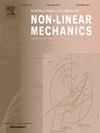Chaotic dynamics of spiral bevel gears
IF 3.2
3区 工程技术
Q2 MECHANICS
International Journal of Non-Linear Mechanics
Pub Date : 2025-04-04
DOI:10.1016/j.ijnonlinmec.2025.105098
引用次数: 0
Abstract
This study investigated the nonlinear dynamics of a Spiral Bevel Gear (SBG) system used in helicopter transmissions. Two approaches were employed to determine the Mesh Stiffness (MS): the average slope method (average-MS) and a hybrid analytical-computational method (adaptive-MS), which accounts for Hertzian contact nonlinearity. The dynamic mesh force was computed using polynomial interpolation techniques and loaded tooth contact analysis. The accuracy of the adaptive-MS approach was validated through comparison with a verified nonlinear finite element method (Nonlinear-FEM) simulation, demonstrating strong agreement. The GearDyns-SBG program was used to solve the system's dynamic model under varying working conditions. Backward and forward simulations were conducted to track stable branches, providing insights into the system's behavior. The study evaluated the dynamic responses based on both mesh stiffness approaches using tools such as FFT spectrum, amplitude-frequency analysis, nonlinear time series analysis, Poincaré maps, phase diagrams, and recurrence plots. The results revealed complex behaviors, including tooth separation, backside contact, boundary crises, and period-doubling cascades. Additionally, the largest Lyapunov exponent and fractal dimension were used to characterize the dynamics and 3D bifurcation analysis captured transitions between regular and chaotic regimes. The periodicity characteristics of the system were evaluated by recurrence quantification analyses. These findings enhance the understanding of nonlinear gear dynamics of SBG and provide reliable methods for predicting and analyzing their behavior.
螺旋锥齿轮混沌动力学
本文研究了用于直升机传动的螺旋锥齿轮(SBG)系统的非线性动力学。采用两种方法确定啮合刚度(MS):平均斜率法(average-MS)和考虑赫兹接触非线性的混合解析-计算法(adaptive-MS)。采用多项式插值技术和加载齿接触分析计算啮合动力。通过与已验证的非线性有限元法(non - linear fem)仿真对比,验证了自适应质谱方法的准确性。利用GearDyns-SBG程序求解了系统在不同工况下的动力学模型。进行了前后模拟以跟踪稳定分支,从而深入了解系统的行为。该研究使用FFT谱、幅频分析、非线性时间序列分析、poincarcarve图、相图和递归图等工具,基于两种网格刚度方法评估了动态响应。结果显示了复杂的行为,包括齿分离,背面接触,边界危机和周期加倍级联。此外,利用最大Lyapunov指数和分形维数来表征动力学特征,三维分岔分析捕获了规则和混沌状态之间的转换。通过循环量化分析评价了系统的周期性特性。这些发现增强了对SBG非线性齿轮动力学的理解,并为预测和分析其行为提供了可靠的方法。
本文章由计算机程序翻译,如有差异,请以英文原文为准。
求助全文
约1分钟内获得全文
求助全文
来源期刊
CiteScore
5.50
自引率
9.40%
发文量
192
审稿时长
67 days
期刊介绍:
The International Journal of Non-Linear Mechanics provides a specific medium for dissemination of high-quality research results in the various areas of theoretical, applied, and experimental mechanics of solids, fluids, structures, and systems where the phenomena are inherently non-linear.
The journal brings together original results in non-linear problems in elasticity, plasticity, dynamics, vibrations, wave-propagation, rheology, fluid-structure interaction systems, stability, biomechanics, micro- and nano-structures, materials, metamaterials, and in other diverse areas.
Papers may be analytical, computational or experimental in nature. Treatments of non-linear differential equations wherein solutions and properties of solutions are emphasized but physical aspects are not adequately relevant, will not be considered for possible publication. Both deterministic and stochastic approaches are fostered. Contributions pertaining to both established and emerging fields are encouraged.

 求助内容:
求助内容: 应助结果提醒方式:
应助结果提醒方式:


